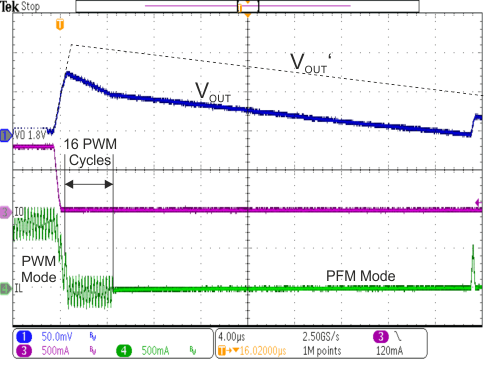SLVSDD1G December 2017 – June 2024 TPS62800 , TPS62801 , TPS62802 , TPS62806 , TPS62807 , TPS62808
PRODUCTION DATA
- 1
- 1 Features
- 2 Applications
- 3 Description
- 4 Device Comparison Table
- 5 Pin Configuration and Functions
- 6 Specifications
-
7 Detailed Description
- 7.1 Overview
- 7.2 Functional Block Diagram
- 7.3 Feature Description
- 7.4 Device Functional Modes
- 8 Application and Implementation
- 9 Device and Documentation Support
- 10Revision History
- 11Mechanical, Packaging, and Orderable Information
Package Options
Refer to the PDF data sheet for device specific package drawings
Mechanical Data (Package|Pins)
- YKA|6
Thermal pad, mechanical data (Package|Pins)
Orderable Information
7.4.4 Optimized Transient Performance from PWM-to-PFM Mode Operation
For most converters, the load transient response in PWM mode is improved compared to PFM mode, because the converter reacts faster on the load step and actively sinks energy on the load release. Compare Figure 8-33 to Figure 8-32. As an additional feature, the TPS6280x automatically enters PWM mode for 16 cycles after a heavy load release to bring the output voltage back to the regulation level faster. After 16 cycles of PWM mode, the device automatically returns to PFM mode (if VSEL/MODE is driven low). See Figure 7-2. Without this optimization, the output voltage overshoot would be higher and would look like the VOUT' trace. This feature is only active after the load is high enough and the converter operates in PWM mode.
 Figure 7-2 Optimized Transient
Performance from PWM-to-PFM Mode
Figure 7-2 Optimized Transient
Performance from PWM-to-PFM Mode